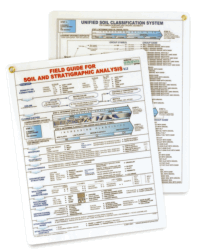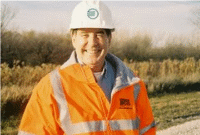
BORING LOGS: Making Soil Descriptions That are Complete, Accurate and Effective
 Boring logs can make or break a project. Good boring logs do their job and become the basis for ground water monitoring systems, foundation and excavation designs and remediation strategies. Poor boring logs cause problems from the very beginning and turn our technical decisions into "best guesses", at best. The consequences of poor boring logs negatively impact our project outcomes, budgets, our company's reputation and our personal performance.
Boring logs can make or break a project. Good boring logs do their job and become the basis for ground water monitoring systems, foundation and excavation designs and remediation strategies. Poor boring logs cause problems from the very beginning and turn our technical decisions into "best guesses", at best. The consequences of poor boring logs negatively impact our project outcomes, budgets, our company's reputation and our personal performance.
This 90-minute webinar provides the tools to improve soil descriptions during hydrogeologic, environmental and engineering projects. Participants will learn to how to improve soil descriptions and site characterization enabling meaningful boring correlation, accurate hydrogeologic assessment, and effective geotechnical design.
Learn to take the mystery out of the subsurface, all the while using standard terms and consistent format. From this webinar, learn how to create boring logs that are:
- Complete,
- Accurate,
- and Effective

Watch a 7-minute Summary on YouTube
Geologists and engineers will appreciate the webinar and gain an advantage by improving the reliability and efficiency of both hydrogeologic and geotechnical site characterization. Experience shows that the best site characterizations occur when field staff have up-to-date skills coupled with the ability to recognize and manage geologic uncertainties as they arise in the field, rather than waiting to evaluate site conditions in the office once the field work is complete.
This webinar will cover the following topics:
- Identifying the components needed to make a description complete as well as meaningful for both geologists and engineers
- Creating boring logs that are: Complete, Accurate and Effective
- Classifying sediments according to the Unified Soil Classification System (USCS)
- Increasing efficiency in field log preparation by using standard terms and format
- Recognizing and avoiding common mistakes and confusing terms

Attendees are invited to actively participate during this live and interactive on-line web seminar. Discussion is planned following the webinar for those who want to continue the session. Bring your questions to the webinar and present them to the instructor and other participants for exploring the best solution.
| Fee: |
299.00 USD Per Computer Site (unlimited participants per site)
249.00 USD Per Computer Site (unlimited participants per site)
when Members also register for the following Webinar:

(discount will be applied during checkout when both are in your cart)
Pay one site registration fee and an unlimited number of participants from your organization can attend at that site.
|
| Instructors: |
Tim Kemmis, PhD., PG, Co-Author of "The Field Guide for Soil and Stratigraphic Analysis"
|
| Handouts: |
Copy of Webinar Slides (pdf)
Record of Attendance Form (pdf)
|
| Duration: |
1.5 hours plus Q&A
(no restrictions on time limit for extra Q&A!)
|
Professional
Development: |
Earn 1.5 Professional Development Hours (1.5 PDH)
 |
A Record of Attendance Form is included free with each webinar for your record keeping and individual PDH verification. We ask your on-site coordinator to return the completed and signed copy of the Form to us following the webinar for (1) maintaining a separate copy as a service to attendees and (2) forwarding to NIU confirming attendance for those who order certificates.
Attendees may also order an official a Course Completion Certificate from Northern Illinois University for a small administrative fee. The Certificate is optional and may be ordered separately following the webinar to confirm your attendance and showcase the certificate on your office wall. Instructions for ordering certificates are given during the webinar.

* This webinar is eligible for the 'BUY THREE, GET THREE' discount; however the two-part webinar series discount shown above cannot be combined with it.

|
Register before September 10th
and receive a FREE
FIELD GUIDE FOR SOIL AND STRATIGRAPHIC ANALYSIS
By Midwest GeoSciences Group
|
"Help yourself to think on your feet in the field"
- Improve the accuracy of your boring logs
- Enhance your soil and sediment descriptions
- Prepare consistent descriptions and meaningful boring logs
- Accurately classify soil in the field using the USCS
- Analyze sedimentary data as the drilling program progresses
- Characterize stratigraphic successions in the field
- Build the geologic framework from boring to boring
- Reduce log editing time
Double-sided, plastic-coated guide for making accurate and complete soil and sediment descriptions on field boring logs. It is intended to improve the analysis of various sedimentary depositional environments applied to both environmental and engineering projects.
PLUS:Register for this webinar and receive an appreciable discount on additional copies of the FIELD GUIDE FOR SOIL AND STRATIGRAPHIC ANALYSIS for your whole project team. Discount only applies during time of webinar registration.
|
Instructors Bio
Tim J. Kemmis, PhD, PG
Senior Geologist Consultant and Project Manager
 Tim Kemmis is a senior geologist consultant and project manager for large-scale hydrogeologic investigations at AECOM in Wisconsin. His unique experience as both an applied researcher and consultant has enabled Tim to effectively mentor staff at all levels on how to unravel sedimentary complexities by making fundamentally sound observations, preparing complete and accurate boring logs and confidently correlating geologic units.
Tim Kemmis is a senior geologist consultant and project manager for large-scale hydrogeologic investigations at AECOM in Wisconsin. His unique experience as both an applied researcher and consultant has enabled Tim to effectively mentor staff at all levels on how to unravel sedimentary complexities by making fundamentally sound observations, preparing complete and accurate boring logs and confidently correlating geologic units.
Tim received his bachelor's degree in agricultural soil science from the University of Illinois and his master's degree in glacial geology while working as a graduate assistant at the Illinois State Geological Survey. He worked 14 years for the Iowa Geological Survey, during which he received his Ph.D., and where he:
- Carried out glacial sedimentologic investigations
- Remapped the Des Moines Glacial lobe
- Established the formal glacial stratigraphy for the lobe based on depositional environments
- Discovered a new type of hummocky glacial topography
- Determined the geometry and origin of jointing in glacial tills
- Developed a lithofacies code to decipher the history of glacial outwash and alluvial sequences
Tim was a co-founder of Midwest GeoSciences Group and has successfully taught many courses and webinars dedicated to improving boring logs and helping geologists think on their feet.